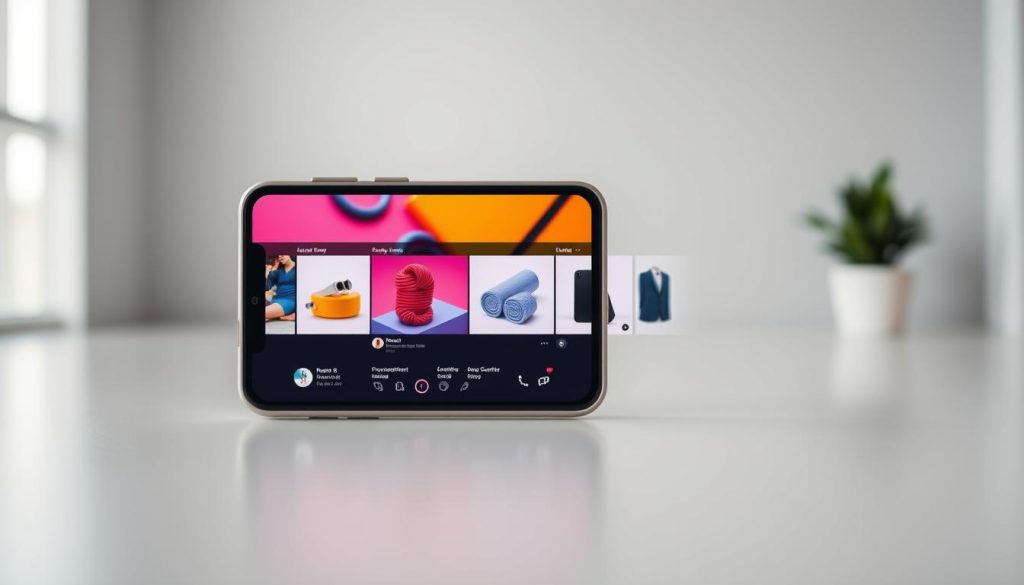We help you tap into the full potential of Carousel Ads, a powerful tool that has revolutionized the way advertisers reach their target audience. With a 30-50% higher conversion rate compared to single-image ads, it’s no wonder Carousel Ads have become a popular choice among advertisers.
By understanding the facebook ads carousel specs, you can create more effective campaigns that drive real results. According to recent data, Carousel Ads can drive lower cost-per-conversions and cost-per-clicks than single-image link ads. We will guide you through the process of unlocking the full potential of Carousel Ads.
Key Takeaways
- Carousel Ads offer higher conversion rates compared to single-image ads
- Understanding carousel ad sizes is crucial for effective campaign creation
- Optimizing facebook carousel ad dimensions can improve ad performance
- Carousel Ads can drive lower cost-per-conversions and cost-per-clicks
- Effective use of Carousel Ads requires a deep understanding of their specs
Understanding Facebook Ads Carousel Overview
By leveraging Facebook’s Carousel ad format, businesses can convey complex messages through a visually appealing, multi-image or video ad. This capability makes Carousel ads a valuable tool in digital marketing, allowing for a more engaging and interactive user experience.
What is a Carousel Ad?
A Facebook Carousel ad is an advertising format that enables advertisers to display multiple images or videos within a single ad, each with its own link. This format provides a unique opportunity to tell brand stories, showcase different products, or highlight various aspects of a service or campaign.

Benefits of Using Carousel Ads
Carousel ads offer several benefits, including increased engagement, improved brand storytelling, and the ability to drive conversions. By showcasing multiple images or videos, businesses can provide a more comprehensive view of their offerings, capturing users’ attention more effectively than single-image ads.
Key benefits include:
- Increased user engagement through interactive and visually appealing content
- Enhanced brand storytelling capabilities
- Improved conversion rates through multiple calls-to-action
Ideal Uses for Carousel Ads in Marketing Campaigns
Carousel ads are versatile and can be used in various marketing campaigns, such as product launches, brand awareness initiatives, and promotional offers. They are particularly effective for businesses with multiple products or services, as they allow for showcasing a range of offerings within a single ad unit.
Ideal uses include:
- Product showcases
- Brand storytelling
- Promotional campaigns
- Event promotions
Key Specifications for Carousel Ads
The success of your Facebook carousel ads hinges on adhering to specific image, video, and text guidelines. To create effective carousel ads, we must consider Facebook’s technical requirements.
Image Size Requirements for Carousel Ads
When it comes to image size, Facebook recommends an 1080 x 1080 pixels resolution with a 1:1 aspect ratio for carousel ads. This ensures that your images are clear and visually appealing across various devices. We recommend using high-quality images that are relevant to your ad content.

Video Specifications for Carousel Ads
For video carousel ads, Facebook has specific guidelines to ensure optimal performance. Videos should be between 4 seconds and 60 minutes long, with a recommended resolution of 1080 x 1080 pixels. The supported video formats include MP4 and MOV. We advise keeping your videos concise and engaging to capture the audience’s attention.
Text Limitations for Carousel Ads
Text plays a crucial role in carousel ads, but there are limitations to be aware of. Facebook recommends keeping your text concise, with a limit of 125 characters for the headline and 90 characters for the description in the ad’s primary text. We suggest focusing on clear, compelling messaging that resonates with your target audience.
By adhering to these specifications, we can ensure that our carousel ads are not only visually appealing but also effective in driving engagement and conversions. Whether you’re showcasing products, telling a story, or promoting a service, following these guidelines is key to a successful Facebook carousel ad campaign.
Crafting Engaging Visuals for Carousel Ads
To maximize the impact of your Facebook carousel ads, it’s crucial to craft engaging visuals that capture your audience’s attention. Recent studies have shown that using high-quality, visually appealing images and videos in carousel ads can increase engagement by up to 50%. This significant boost in engagement can be the difference between a successful campaign and one that falls flat.
Engaging visuals are not just about aesthetics; they play a critical role in communicating your brand’s message and driving user interaction. By focusing on creating compelling carousel ad visuals, you can elevate your advertising strategy and achieve better results.
Selecting Compelling Images for Carousel Ads
Selecting the right images for your carousel ads is a critical step in capturing your audience’s attention. Here are some best practices to follow:
- Use high-resolution images that are clear and visually appealing.
- Ensure images are relevant to your message and resonate with your target audience.
- Maintain a consistent visual theme across all cards in your carousel ad to reinforce your brand identity.
Image Specifications: Facebook recommends using images with a minimum resolution of 1080 x 1080 pixels for optimal display. Adhering to these specifications ensures that your images are crisp and engaging on various devices.
| Image Aspect Ratio | Recommended Resolution | File Format |
|---|---|---|
| 1:1 | 1080 x 1080 pixels | JPEG or PNG |
| 4:5 | 1080 x 1350 pixels | JPEG or PNG |
Designing Effective Video Content for Carousel Ads
Videos can add a dynamic element to your carousel ads, providing an engaging way to tell your brand’s story. To create effective video content, consider the following:
Keep it concise: Ensure your videos are short and to the point, capturing viewers’ attention within the first few seconds.
Focus on quality: Use high-quality video production to maintain a professional look and feel.
When incorporating videos into your carousel ads, it’s essential to follow Facebook’s video specifications to ensure optimal playback. Facebook supports various video formats, but it’s recommended to use MP4 or MOV files for compatibility.

By focusing on crafting engaging visuals, including both compelling images and effective video content, you can significantly enhance the performance of your carousel ads. Remember, the key to success lies in creating a visually appealing narrative that resonates with your audience and drives meaningful interactions.
Writing Effective Copy for Carousel Ads
Crafting compelling copy for carousel ads is crucial for capturing audience attention and driving campaign success. To achieve this, we need to focus on two critical elements: headlines and descriptions.
Tips for Captivating Headlines in Carousel Ads
Your headline is the first thing users see, making it a crucial factor in grabbing their attention. According to Facebook’s guidelines, the recommended headline length for carousel ads is 40 characters. To make the most of this limited space, we should:
- Be concise and clear about the value proposition
- Use action-oriented language to encourage engagement
- Avoid jargon and overly technical terms
By following these tips, we can create headlines that not only capture attention but also drive user engagement.
Crafting Persuasive Descriptions for Carousel Ads
The description provides an opportunity to elaborate on the message and persuade the user to take action. With a maximum of 20 characters for link descriptions, we must be strategic. Here are some best practices:
- Focus on the key benefit or unique selling point
- Use persuasive language that resonates with the target audience
- Include a clear call-to-action (CTA) to guide the user’s next step
To illustrate the effectiveness of well-crafted copy, let’s examine a comparison of different approaches:
| Copy Element | Ineffective Copy | Effective Copy |
|---|---|---|
| Headline | “Learn More About Our Product” | “Discover How Our Product Can Boost Your Sales” |
| Description | “Click here for more info” | “Get Started Today and See Results in 30 Days” |
As shown in the table, effective copy is clear, persuasive, and focused on the benefits that matter most to the audience.

By applying these strategies and best practices, we can create carousel ad copy that not only engages our audience but also drives meaningful results for our campaigns.
Targeting Your Audience with Carousel Ads
The key to unlocking the full potential of Facebook Ads Carousel lies in precise audience targeting. To achieve this, we need to understand who our audience is and how they interact with our content.
Effective targeting involves using audience insights to inform our strategy. By analyzing data on our audience’s demographics, interests, and behaviors, we can create highly targeted campaigns that resonate with them.
Audience Insights for Better Targeting
Facebook provides a wealth of information about our audience through its Audience Insights tool. This tool allows us to gain a deeper understanding of our target audience, including their demographics, interests, and online behaviors.
By leveraging these insights, we can tailor our carousel ad content to better match the needs and preferences of our audience. For instance, if our audience insights reveal that our target audience is predominantly young adults interested in technology, we can create carousel ads that highlight the tech-savvy features of our product or service.
Recent studies have shown that using audience insights can improve the effectiveness of carousel ad campaigns by up to 30%. This significant boost in performance underscores the importance of understanding our audience.

A/B Testing Your Carousel Ad Campaigns
In addition to using audience insights, A/B testing is a crucial strategy for optimizing our carousel ad campaigns. By creating multiple versions of our ads and testing them against each other, we can identify which elements perform best with our target audience.
A/B testing can involve experimenting with different images, headlines, descriptions, or call-to-actions. For example, we might create two versions of a carousel ad with different images and compare their performance to see which one generates more engagement.
As noted by marketing expert, “A/B testing is not just about finding what works; it’s about continually optimizing and improving our campaigns to achieve better results.” By embracing A/B testing, we can refine our targeting strategy and maximize our ROI.
To implement A/B testing effectively, we should follow a structured approach:
- Identify the elements we want to test.
- Create multiple versions of our ad.
- Run the tests simultaneously to ensure comparable results.
- Analyze the performance data to determine the winning version.
- Apply the insights gained to future campaigns.
By combining audience insights with A/B testing, we can develop a powerful targeting strategy for our carousel ads that drives real results.
Best Practices for Carousel Ad Layouts
To maximize the impact of your Facebook Ads Carousel, it’s crucial to understand the best practices for creating effective ad layouts. A well-structured Carousel Ad can significantly boost your campaign’s performance by engaging your audience and driving results.
According to Facebook’s guidelines, the recommended number of cards for Carousel Ads is between 2-10. This range allows for flexibility in presenting your message without overwhelming your audience.
Organizing Your Carousel Ad Order for Maximum Impact
The order of your Carousel Ad cards is crucial for telling a cohesive story and guiding the user through your message. Start with a strong, attention-grabbing card that sets the tone for the rest of your ad. Each subsequent card should build upon the previous one, creating a narrative that resonates with your audience.
For instance, you can begin with an introductory card that presents your brand or product, followed by cards that highlight key features or benefits. “The key is to create a flow that keeps users engaged and interested in your content.”
Utilizing Call-to-Actions Effectively in Carousel Ads
Call-to-actions (CTAs) play a vital role in driving user engagement and conversions. In Carousel Ads, you can include a CTA in each card or strategically place them throughout the ad. Use action-oriented language that encourages users to take the desired action, such as “Shop Now,” “Learn More,” or “Sign Up.”
“A well-crafted CTA can be the difference between a user scrolling past your ad and engaging with your brand.”
Consider using a mix of CTAs that cater to different stages of the customer journey. For example, you can use “Learn More” for awareness and “Buy Now” for conversions.
Keeping Consistent Branding Throughout Carousel Ads
Consistency is key to building brand recognition and trust. Ensure that your Carousel Ad maintains a consistent visual identity and tone across all cards. Use a cohesive color scheme, typography, and imagery that aligns with your brand guidelines.

By maintaining a consistent brand image, you can reinforce your message and make your ad more memorable. As noted by marketing experts, “Consistency in branding is crucial for building recognition and trust with your target audience.”
By implementing these best practices for Carousel Ad layouts, you can create engaging, effective ads that drive real results for your campaigns.
Measuring Success of Carousel Ads
Measuring the success of your Carousel Ads is pivotal to understanding their effectiveness and making data-driven decisions. To achieve this, we need to focus on the right metrics and utilize the appropriate tools for analysis.
Key Metrics to Track
To gauge the performance of your Carousel Ads, we must track key metrics that provide insights into their effectiveness. Some of the crucial metrics include:
- Click-Through Rate (CTR): This metric indicates how often people click on your ad after seeing it.
- Conversion Rate: It measures the percentage of users who complete a desired action after clicking on your ad.
- Return on Ad Spend (ROAS): This metric helps you understand the revenue generated by your ad campaign compared to its cost.
- Cost Per Click (CPC): It measures the cost of each click on your ad, helping you optimize your budget.
Tools for Analyzing Campaign Performance
To analyze the performance of your Carousel Ads effectively, we can leverage several tools provided by Facebook and third-party platforms.
Facebook Ads Manager is a powerful tool that offers comprehensive insights into your ad campaigns, including metrics such as reach, impressions, clicks, and conversions. It allows us to track the performance of individual ads within a carousel, making it easier to identify top-performing content.
Additionally, third-party analytics tools can provide more granular data and insights, helping us refine our targeting and ad creative strategies.
By combining these metrics and tools, we can gain a deeper understanding of our Carousel Ad performance and make informed decisions to optimize our campaigns.
Troubleshooting Common Issues with Carousel Ads
Troubleshooting is a crucial step in optimizing your Facebook Carousel Ad campaigns for better performance. Despite their potential, carousel ads can sometimes underperform due to avoidable mistakes or unforeseen issues.
To get the most out of your carousel ad campaigns, it’s essential to identify and rectify common problems. We will explore the key areas to focus on for effective troubleshooting.
Ad Creation Mistakes to Avoid in Carousel Ads
Creating effective carousel ads requires attention to detail and adherence to best practices. Common mistakes include using low-quality images, crafting ineffective ad copy, and poor targeting. According to Facebook’s guidelines, using high-quality, visually appealing images is crucial for capturing user attention.
- Ensure images are clear and relevant to your message.
- Craft ad copy that is concise, compelling, and aligned with your target audience’s interests.
- Use Facebook’s targeting options to precisely reach your desired audience.
For more insights on creating effective ad campaigns, visit our paid advertising services page.
Fixing Performance Problems with Carousel Ads
Even well-crafted carousel ads can sometimes underperform. To fix performance issues, it’s crucial to monitor key metrics and adjust your strategy accordingly. Common performance problems include low engagement rates and poor conversion rates.
To address these issues, we recommend:
- Regularly reviewing your ad metrics to identify areas for improvement.
- A/B testing different ad elements, such as images, headlines, and call-to-actions, to optimize performance.
- Adjusting your targeting parameters to better align with your ideal audience.
By following these troubleshooting steps and avoiding common ad creation mistakes, you can significantly enhance the performance of your carousel ad campaigns.
Future Trends in Facebook Ads Carousel Usage
As we look ahead, it’s clear that Facebook Ads Carousel will continue to play a significant role in digital marketing strategies. Recent studies have shown that using innovative ad formats such as carousel ads can increase engagement by up to 50%. This upward trend is expected to continue, driven by advancements in carousel ad innovations and a deeper understanding of carousel ad audience preferences.
Emerging Innovations
We anticipate that future trends in facebook ads carousel trends will include more sophisticated use of multimedia content, such as interactive videos and immersive experiences. Brands will leverage these innovations to capture user attention and drive meaningful interactions.
Shifting Audience Preferences
To stay ahead, advertisers must adapt to changing carousel ad audience preferences. This includes personalizing content, optimizing for mobile, and ensuring seamless user experiences. By doing so, businesses can maximize their ROI and achieve their marketing goals.
By staying informed about the latest facebook ads carousel trends and best practices, marketers can continue to harness the power of carousel ads to drive results.
